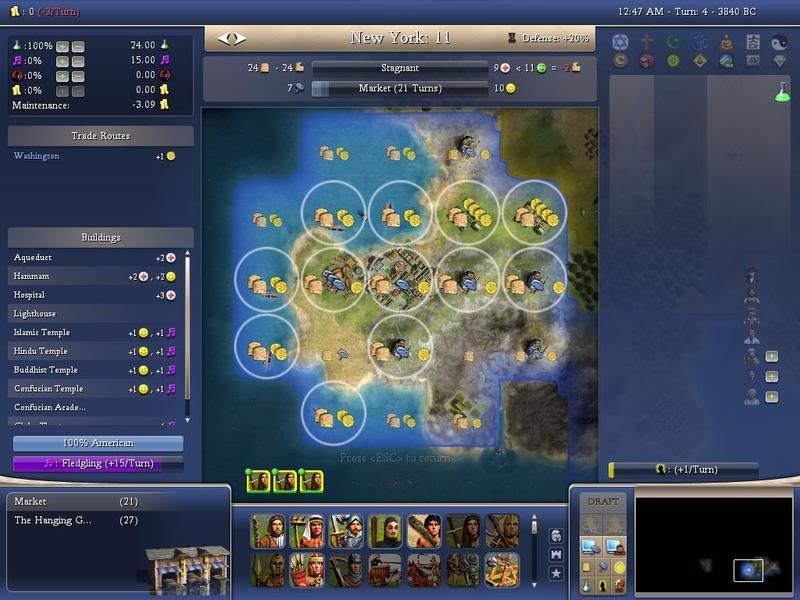A pre RP windmill is +1

, congrats you've just converted your hill into a brown farm. Rather than growing if that is my best tile to work, I will almost invariably work a specialist. This means I get a better

->

conversion from whipping. Early in the game I try not to settle in locations where I can't have substantial for surpluses (those can be backfilled later). Even worse, if I'm at the healthy/happy cap I actually get less from more food; the value of GPP has not dropped down yet.
Several points:
GPP are useless in cities that will never pop a great person. Less than half of my cities usually pop a GP because some go at such a fast rate. So you are then running a specialist for the flat bonuses it gets. +2 hammers from an engineer, assuming you don't have representation.
You run your engineer in your smaller cities, I'll run my plains hill windmill (1 F, 3 H, 1 C, even pre replaceable parts, 1 F 2 H 1 C is better in some cities instead of 0 F 4 H) along with half of another tile provided for, which you can add to the effective output of the windmill.
I think people underestimate the effect of one commerce. It is small, but it adds up. You can't ignore it when determining the value of windmills.
And at a certain point you will most likely leave slavery. This increases the value of having many tiles worked.
Late game I'd normally rather run fewer windmills and more watermills/biology farms for production (windmilling over the mines in commerce cities only after I have all my desired infrastructure, unless I decide I need lots of crappy military production).
Farms are inefficient when it comes to maximizing a cities raw output, meaning base commerce + hammers. This is because with more farms you reach the health limit quicker, at which point the only output you get from working each 4 food farm is one food (2 food to sustain the farm, 1 food for sickness, equals 1 extra).
The only cases where I would usually spam farms like that is when I am trying to build more specialists(either in representation, or GP farm), or if I am focusing on production(through hills or increased slavery rate)... or increasing votes.
Also, consider the case when you don't have access to fresh water or rivers, and don't want to chain-irrigate over pre-existing improvements. In that case you can't utilize your farm/watermill strategy. Regardless, it is a somewhat manufactured conflict, as watermills and farms don't utilize the same tiles. They can't be built on hills.
You may think any city that can't build farms/watermills is useless, but a size 10 city with lots of hills, sustaining steady growth through windmills, is a useful addition to an empire imo. The windmills can be used in a coastal city with little production or surplus food... even a 2 F 1 H 1 C tile (pre Replaceable parts grassland windmill) is a useful addition to an otherwise coastal/barren city.
Windmills are the absolute only source of extra food for hills. I think the value of them can largely be summed up with that fact.
 ; by my earlier numbers this should show that a financial hill is better off as an environmentalist windmill than a SP mine. Food is a bit more dicey. You have the potential for getting "8
; by my earlier numbers this should show that a financial hill is better off as an environmentalist windmill than a SP mine. Food is a bit more dicey. You have the potential for getting "8  " out of environmentalism if you are huge, which should negate most of the waterwheel bonus. Which then makes it a question of how many mines vs WS you plan to have. Without hills and few enough rivers, I'm wondering if environmentalism might actually come out on top ahead of FM and SP.
" out of environmentalism if you are huge, which should negate most of the waterwheel bonus. Which then makes it a question of how many mines vs WS you plan to have. Without hills and few enough rivers, I'm wondering if environmentalism might actually come out on top ahead of FM and SP. ; by my earlier numbers this should show that a financial hill is better off as an environmentalist windmill than a SP mine. Food is a bit more dicey. You have the potential for getting "8
; by my earlier numbers this should show that a financial hill is better off as an environmentalist windmill than a SP mine. Food is a bit more dicey. You have the potential for getting "8  " out of environmentalism if you are huge, which should negate most of the waterwheel bonus. Which then makes it a question of how many mines vs WS you plan to have. Without hills and few enough rivers, I'm wondering if environmentalism might actually come out on top ahead of FM and SP.
" out of environmentalism if you are huge, which should negate most of the waterwheel bonus. Which then makes it a question of how many mines vs WS you plan to have. Without hills and few enough rivers, I'm wondering if environmentalism might actually come out on top ahead of FM and SP.

 to 1 hammer. Given the multipliers for
to 1 hammer. Given the multipliers for  For example, when you have replaceable parts and are either running state property or are lacking one of railroads and biology.
For example, when you have replaceable parts and are either running state property or are lacking one of railroads and biology.






